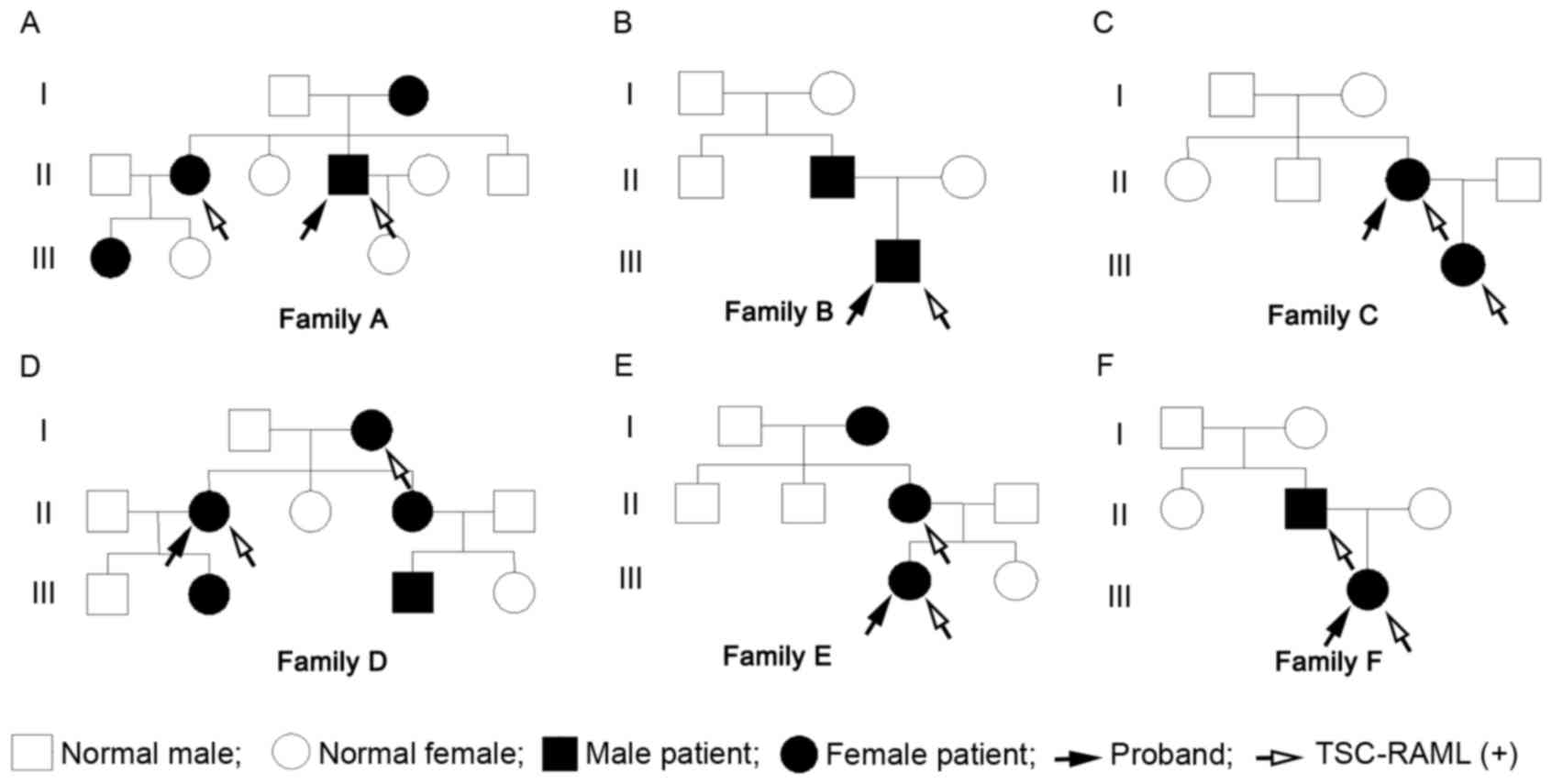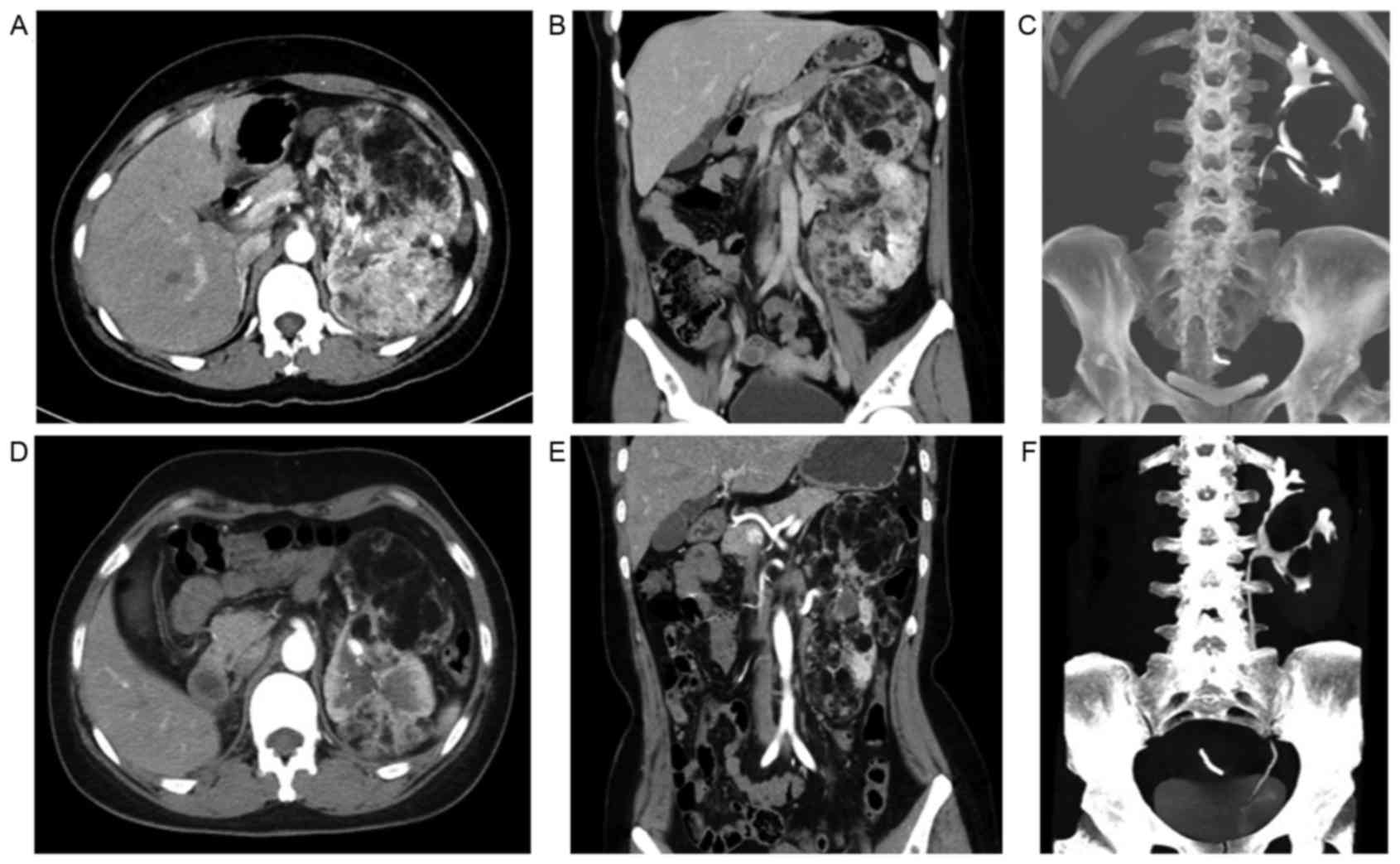|
1
|
Curatolo P, Bombardieri R and Jozwiak S:
Tuberous sclerosis. Lancet. 372:657–668. 2008. View Article : Google Scholar : PubMed/NCBI
|
|
2
|
Krueger DA and Northrup H; International
Tuberous Sclerosis Complex Consensus Group, . Tuberous sclerosis
complex surveillance and management: Recommendations of the 2012
international tuberous sclerosis complex consensus conference.
Pediatr Neurol. 49:255–265. 2013. View Article : Google Scholar : PubMed/NCBI
|
|
3
|
Rosser T, Panigrahy A and McClintock W:
The diverse clinical manifestations of tuberous sclerosis complex:
A review. Semin Pediatr Neurol. 13:27–36. 2006. View Article : Google Scholar : PubMed/NCBI
|
|
4
|
O'Callaghan FJ, Noakes MJ, Martyn CN and
Osborne JP: An epidemiological study of renal pathology in tuberous
sclerosis complex. BJU Int. 94:853–857. 2004. View Article : Google Scholar : PubMed/NCBI
|
|
5
|
Rakowski SK, Winterkorn EB, Paul E, Steele
DJ, Halpern EF and Thiele EA: Renal manifestations of tuberous
sclerosis complex: Incidence, prognosis and predictive factors.
Kidney Int. 70:1777–1782. 2006. View Article : Google Scholar : PubMed/NCBI
|
|
6
|
Demuth D, Nasuti P, Lucchese L, Gray L,
Pinnegar A and Magestro M: Economic impact of patients with
tuberous sclerosis complex (tsc) in the Uk: A retrospective
database analysis in the clinical practice research datalink
(Cprd). Value in Health. 17:A1372014. View Article : Google Scholar
|
|
7
|
Rentz AM, Skalicky AM, Liu Z, Wheless JW,
Dunn DW, Frost MD, Nakagawa J, Magestro M and Prestifilippo J:
Tuberous sclerosis complex: A survey of health care resource use
and health burden. Pediatr Neurol. 52:435–441. 2015. View Article : Google Scholar : PubMed/NCBI
|
|
8
|
Kakkar A, Vallonthaiel AG, Sharma MC, Bora
G, Panda A and Seth A: Composite renal cell carcinoma and
angiomyolipoma in a patient with Tuberous sclerosis: A diagnostic
dilemma. Can Urol Assoc J. 9:E507–E510. 2015. View Article : Google Scholar : PubMed/NCBI
|
|
9
|
Falsafi P, Taghavi-Zenouz A,
Khorshidi-Khiyavi R, Nezami N and Estiar MA: A case of tuberous
sclerosis without multiorgan involvement. Glob J Health Sci.
7:124–131. 2015. View Article : Google Scholar : PubMed/NCBI
|
|
10
|
Xue G, Han X, Ren S and Yue X: An Analysis
of 11 Cases of Tuberous Sclerosis from Three Genealogies. Chin J
Neuroimmunol and Neurol. 6:249–252. 1999.
|
|
11
|
Zhang Y, Gan J, Pu Z, Xu Mm, Wang LF, Li
YH and Liu ZG: TSC1 R509X mutation in a chinese family with
tuberous sclerosis complex. Neuromolecular Med. 17:202–208. 2015.
View Article : Google Scholar : PubMed/NCBI
|
|
12
|
Dixon BP, Hulbert JC and Bissler JJ:
Tuberous sclerosis complex renal disease. Nephron Exp Nephrol.
118:e15–e20. 2011. View Article : Google Scholar : PubMed/NCBI
|
|
13
|
Northrup H and Krueger DA; International
Tuberous Sclerosis Complex Consensus Group, . Tuberous sclerosis
complex diagnostic criteria update: Recommendations of the 2012
international tuberous sclerosis complex consensus conference.
Pediatr Neurol. 49:243–254. 2013. View Article : Google Scholar : PubMed/NCBI
|
|
14
|
Tee AR, Manning BD, Roux PP, Cantley LC
and Blenis J: Tuberous sclerosis complex gene products, Tuberin and
Hamartin, control mTOR signaling by acting as a GTPase-activating
protein complex toward Rheb. Curr Biol. 13:1259–1268. 2003.
View Article : Google Scholar : PubMed/NCBI
|
|
15
|
Wataya-Kaneda M: Mammalian target of
rapamycin and tuberous sclerosis complex. J Dermatol Sci.
79:93–100. 2015. View Article : Google Scholar : PubMed/NCBI
|
|
16
|
Sancak O, Nellist M, Goedbloed M,
Elfferich P, Wouters C, Maat-Kievit A, Zonnenberg B, Verhoef S,
Halley D and van den Ouweland A: Mutational analysis of the TSC1
and TSC2 genes in a diagnostic setting: Genotype--phenotype
correlations and comparison of diagnostic DNA techniques in
Tuberous Sclerosis Complex. Eur J Hum Genet. 13:731–741. 2005.
View Article : Google Scholar : PubMed/NCBI
|
|
17
|
Au KS, Williams AT, Roach ES, Batchelor L,
Sparagana SP, Delgado MR, Wheless JW, Baumgartner JE, Roa BB,
Wilson CM, et al: Genotype/phenotype correlation in 325 individuals
referred for a diagnosis of tuberous sclerosis complex in the
United States. Genet Med. 9:88–100. 2007. View Article : Google Scholar : PubMed/NCBI
|
|
18
|
De Waele L, Lagae L and Mekahli D:
Tuberous sclerosis complex: The past and the future. Pediatr
Nephrol. 30:1771–1780. 2015. View Article : Google Scholar : PubMed/NCBI
|
|
19
|
Seyam RM, Bissada NK, Kattan SA, Mokhtar
AA, Aslam M, Fahmy WE, Mourad WA, Binmahfouz AA, Alzahrani HM and
Hanash KA: Changing trends in presentation, diagnosis and
management of renal angiomyolipoma: Comparison of sporadic and
tuberous sclerosis complex-associated forms. Urology. 72:1077–1082.
2008. View Article : Google Scholar : PubMed/NCBI
|
|
20
|
DiMario FJ Jr, Sahin M and
Ebrahimi-Fakhari D: Tuberous sclerosis complex. Pediatr Clin North
Am. 62:633–648. 2015. View Article : Google Scholar : PubMed/NCBI
|
|
21
|
Ruppe V, Dilsiz P, Reiss CS, Carlson C,
Devinsky O, Zagzag D, Weiner HL and Talos DM: Developmental brain
abnormalities in tuberous sclerosis complex: A comparative tissue
analysis of cortical tubers and perituberal cortex. Epilepsia.
55:539–550. 2014. View Article : Google Scholar : PubMed/NCBI
|
|
22
|
Chan JY, Wang KH, Fang CL and Chen WY:
Fibrous papule of the face, similar to tuberous sclerosis
complex-associated angiofibroma, shows activation of the mammalian
target of rapamycin pathway: Evidence for a novel therapeutic
strategy? PLoS One. 9:e894672014. View Article : Google Scholar : PubMed/NCBI
|
|
23
|
Bissler JJ, Kingswood JC, Radzikowska E,
Zonnenberg BA, Frost M, Belousova E, Sauter M, Nonomura N,
Brakemeier S, de Vries PJ, et al: Everolimus for angiomyolipoma
associated with tuberous sclerosis complex or sporadic
lymphangioleiomyomatosis (EXIST-2): A multicentre, randomised,
double-blind, placebo-controlled trial. Lancet. 381:817–824. 2013.
View Article : Google Scholar : PubMed/NCBI
|
|
24
|
Bissler JJ, Kingswood JC, Radzikowska E,
Zonnenberg BA, Frost M, Belousova E, Sauter M, Nonomura N,
Brakemeier S, de Vries PJ, et al: Everolimus for renal
angiomyolipoma in patients with tuberous sclerosis complex or
sporadic lymphangioleiomyomatosis: Extension of a randomized
controlled trial. Nephrol Dial Transplant. 31:111–119. 2015.
View Article : Google Scholar : PubMed/NCBI
|













